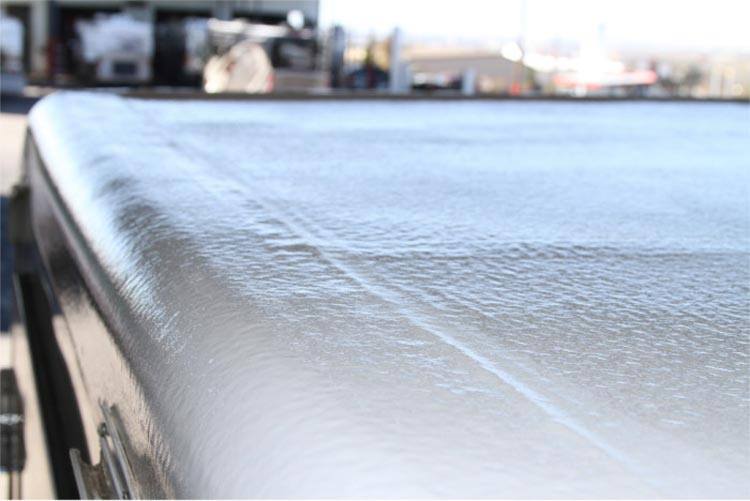Your RV’s roof plays a role in keeping your vehicle safe and comfortable, so it’s vital to inspect it for any signs of damage. By following these steps, you can ensure that your roof remains in good condition and that your travels are smooth and secure.
The first step in assessing your RV roof for damage is to look for clues. These may include cracks, holes, or other obvious signs of wear. Make sure to examine all parts of the roof, including the edges and seams. If you spot any damage, it’s essential to address it to prevent issues.
Another key aspect of evaluating your roof is checking the sealant regularly. The sealant plays a role in maintaining the integrity of the roof and any damage to it can result in leaks or structural problems. Look out for cracks wear or discoloration in the sealant. If you notice any of these issues, sealant is crucial.
Apart from damage indicators, don’t forget to inspect the roof for signs of water damage.
Make sure to search for any water marks, mold or mildew. If you spot any of these issues, it’s crucial to inspect the area to pinpoint the source of water damage and get it fixed promptly.
Additionally, it’s essential to conduct checks on your roof for dangers. Keep an eye out for debris or sharp objects that could harm the roof or pose risks to people and animals, around the RV. Remove any items and dispose of them correctly.
By examining your RV roof for indications of damage, you can maintain your vehicle in excellent shape and ensure a safe and pleasant journey.
6 Steps to Inspect RV Roof for Damage
1. Ground Inspection: Regularly examine your RV roof from the ground level. Look for signs of wear, such as cracks, tears, or discoloration.
2. Climbing the Ladder: If a detailed inspection is required, climb onto the roof using a ladder while wearing appropriate safety gear.
3. Leak Detection: Check for any signs of water damage, such, as spongy areas.
If you notice any, it could mean that water is getting into your RV.
4. Check for Holes: Look for any openings or holes, in the roof. If you discover any, it might be necessary to fix them or replace the roof.
5. Inspect the Joints: Look for any openings in the RV roof’s joints. Gaps can result in leaks and water damage.
6. Watch out for any distortion on the roof: Distortion could indicate damage. Should be dealt with promptly.
How to Identify RV Roof Leaks and Damage
Identifying water damage and roof leaks on your RV is crucial to preventing harm and expensive repairs. There are methods to detect indications of water damage on your RVs roof.
Initially, examine your RV roof from a distance for signs of harm, like cracked or absent caulking, rust, or torn rubber seals. If you spot any of these signs it’s vital to address the problem
Then climb onto your RVs roof. Inspect it for signs of damage. Look for cracks, tears or bulges on the surface of the roof.
Don’t forget to check for any areas or puddles of water.
If you spot any of these problems, make sure to examine the inside of your RV for any indications of water damage. Search for water marks on the walls, ceilings, and floors. Keep an eye out for smells and any signs of mold or mildew growth.
If you discover any indications of water damage, it’s crucial to act to fix the roof leak. It’s advisable to inspect the roof for damage and carry out any needed repairs.
By checking your RV’s roof and addressing issues promptly, you can avoid repairs and keep your RV in excellent condition.
How to Check Your RV Roof for Damage
RV roofs are susceptible to wear and tear because they are constantly exposed to the elements. Regularly examining your RV roof is vital in order to prevent damage and costly repairs. Here are some suggestions to assist you in inspecting your RV roof for damage.
Begin with a Visual Examination – Start by inspecting the roof from ground level. Look out for signs of wear, such as cracks, tears, or changes in color.
Make sure to inspect around any fixtures or protrusions, like vents or AC units.
Search for Leaks. If you observe any signs of water damage, it’s important to examine the roof for leaks. Look for spots on the roof and any water stains or mold growth on the ceiling or walls inside the RV. If you discover spots, use a garden hose to spray the roof and check for leaks.
Inspect the Seams – Pay attention to the seams of the roof, where damage is most likely to occur. Check for any signs of separation or gaps. Also, examine the caulking around the edges of the roof to ensure it’s still intact.
Touch Test. Use your hands to feel for spots or dents on the roof. This could indicate water damage. Rotting beneath the surface.
Examine Roof Vents – Confirm that all roof vents are securely fastened and that their seals are in condition.
By following these guidelines,, you can help keep your RV roof in shape and prevent repair costs.
If you happen to spot damage or find yourself unable to fix it on your own it’s advisable to reach out to a RV repair service, for help.
Steps to Take When Dealing with RV Roof Damage
Upon noticing damage on your RVs roof prompt action is vital to prevent harm and costly repairs. Taking the measures can safeguard your vehicle. Ensure its safe usability.
Start by determining the cause of the damage. If it results from a tree branch or any foreign object remove it. Check for harm. For issues like leaks or structural problems seek assistance from a skilled RV technician.
After identifying the source of damage, thoroughly examine it to assess its extent. Minor cracks, punctures, and tears can often be fixed with suitable roof products. Extensive damage may require replacing the roof.
If your RV roof needs repair or replacement, contact your insurance provider first to understand coverage details. Many policies include protection for damage caused by falling objects or unforeseen events.
After you’ve figured out how to proceed, make sure to address any issues with your RV’s roof by either fixing it yourself or getting help from an RV specialist. Once the repairs are done, remember to check the roof to keep it in shape and prevent any further damage. Being proactive can save you time and money down the road.



